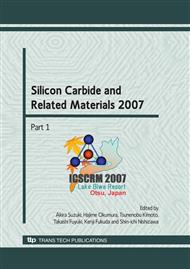p.151
p.155
p.159
p.163
p.167
p.171
p.175
p.179
p.183
Micropipe Dissociation through Thick n+ Buffer Layer Growth
Abstract:
Thick (> 25 µm) 4H n+ epitaxial layer growth was performed on 4H n+ substrates utilizing chlorine containing etch chemistries in a hot wall CVD system. Optimization of the n+ epitaxial layer growth was achieved by varying C/Si ratio and N2 flow. Desired epitaxial layers have doping levels > 5x1018 cm-3, epitaxial surface roughness <10 nm on a 20x20 µm area and overall micropipe density reduction. To confirm the conversion of micropipes into closed core screw dislocations, microscopic examination of the epitaxial and wafer surfaces was carried out after KOH etching. Grazing incidence x-ray topography (XRT) as well as cross sectional XRT and microscopy were also performed. The cross sectional evaluation showed that the dissociation of the micropipes occurs very close to the epitaxy/wafer interface.
Info:
Periodical:
Pages:
167-170
Citation:
Online since:
September 2008
Authors:
Keywords:
Price:
Сopyright:
© 2009 Trans Tech Publications Ltd. All Rights Reserved
Share:
Citation:


